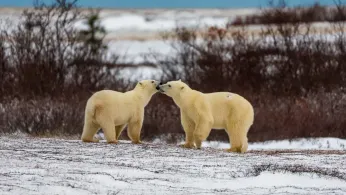
4 hours ago
5 Reasons to Put Churchill on Your Travel Bucket List
Alec Sills-Trausch | Guessing Headlights READ TIME: 3 MIN.
Each fall, Churchill, a town of 800, swells into the thousands as wildlife photographers and bear lovers travel to the small town on the shores of Hudson Bay, in Northern Canada, to see the magic of polar bears.
This November, I had the opportunity to visit Churchill, Manitoba, the Polar Bear Capital of the World. While I only had a day to visit, it cemented itself as one of the most memorable adventures I've taken.
Getting to watch and photograph the polar bears roughhousing for hours on one side of the Tundra Buggy, while mom and cub walked on the other, was incredible.
It's undoubtedly a trip that you will remember, because I know I will.
It's the Polar Bear Capital of the World
The single reason Churchill is so famous is for its polar bears. Each fall, hundreds and hundreds of polar bears congregate along the shore of the Hudson Bay, waiting for the sea ice that will allow them to begin hunting their favorite meal: seals.
Because the sea ice never comes at the same time, the bears end up hanging out around Churchill for weeks at a time, even outnumbering the local population.
Mid-October to mid-November is the best time to visit, as that's when the most polar bears are present. And once the sea ice is strong enough, the bears seemingly disappear overnight.
See pictures of polar bears from Churchill.
Great Chance To See Northern Lights
If you look at a map, Churchill is incredibly far north, and with that comes fantastic opportunities for northern lights. If you have clear night skies from September through April, you're very likely to see the northern lights.
Confirm with your hotel or lodge if they do a northern lights wake-up call. If not, it'll be on you to stay up late into the night and catch the sky magic.
Unique Community With No Roads Connecting It to the Rest of the World
Churchill has about 800 full-time residents and is completely cut off from the Canadian road system. The only way in or out is by plane or train (with the occasional cruise ship).
This area has a long history thanks to the Hudson Bay Company, but is now almost squarely supported by tourism across the three seasons. (Spring is the only season without a major tourism push.)
With museums, the SeaWall murals, and dog sledding, there's plenty to do outside of wildlife and the Aurora Borealis.
Spend Time With Thousands of Beluga Whales
Each summer, 50,000 beluga whales filter into the shallow, warmer waters of Hudson Bay to give birth, feed, and mate. A small portion of that, 3,000-4,000, comes to the mouth of the Churchill River. Here, you have the opportunity to kayak and boat near them, gaining unprecedented access to these beautiful animals.
Nicknamed "sea canaries", if you put your head underwater near them, you might be able to hear them communicating amongst themselves.
Changing Climate Adversely Impacting Polar Bears
As the Earth warms, the sea ice that polar bears rely on for their livelihood shrinks. With sea ice taking longer to form in the fall and melting faster in the spring, polar bears have a shorter window for feasting on seals that make up the majority of their diet. This is the biggest cause for alarm. Polar bear populations are declining as the effects of climate change intensify, with warming oceans.
The Western Hudson Bay bears have seen their numbers decreasing, with a 2021 survey showing a 27% decrease from 2016 estimates. This means the time is now to see them before numbers continue to shrink.
New tundra buggy EV 1
One way the community is reducing its carbon emissions is by transitioning from diesel to electric buggies.
The newest buggy is the Tundra Buggy EV 1, a state-of-the-art vehicle from Frontier's North and Polar Bears International. It will allow Polar Bears International, a not-for-profit group focused solely on protecting polar bears, to have longer access to the animals and a better ability to communicate with the outside world from such a remote area.
This zero-emission research and outreach vehicle allows scientists, media teams, and visitors to observe and live-stream polar bears up close, all while significantly cutting carbon pollution and proving that clean energy can not only endure but excel in the extreme subarctic environment.
If you're curious for more information about climate change and polar bears, check out the work Polar Bear International is doing to protect polar bears throughout the Arctic.






